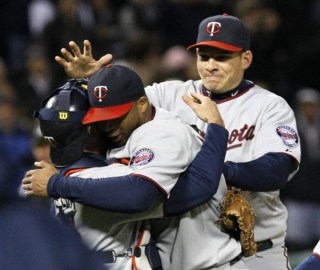This isn't just because he is the team's best player. It's also because no position carried less depth in the Twins organization than catcher. Mauer was able to start only 47 games behind the plate, and when he was unavailable those nods largely went to Drew Butera, whose miserable .167/.210/.239 hitting line tagged him with the second-worst OPS in the majors among players with 200 or more plate appearances.
Shockingly, Butera might have actually been the best option. When the alternatives are Rene Rivera and Steve Holm - similarly inept hitters who provide less value with the mitt - it's hard to fault Ron Gardenhire for continually writing in Butera's name with the starter sidelined.
Gardenhire's affinity for Butera may have played a role in the front office failing to provide adequate depth at catcher, but there's no question that it was a massive tactical misstep displaying a glaring lack of foresight, especially considering that Mauer's health had already shown signs of deteriorating late in the 2010 season.
Mauer's health remains a question mark as we head into the 2012 campaign, and even if he shakes his injury concerns there's still a good chance he'll spend significant time away from catcher. Butera remains on the roster, but fortunately there are a couple guys who can legitimately push him for the top backup job this year.
One of those players is J.R. Towles, who was signed as a minor-league free agent back in December. Towles, who came up in the Astros system, holds a Butera-esque .187/.267/.315 hitting line in 484 major-league plate appearances. However, while one would expect Butera's horrendous offensive production in the bigs based on his .613 career OPS in the minors, Towles absolutely raked at every level of Houston's system, accumulating a .295/.394/.465 line in 409 minor-league games, including an .831 OPS at Triple-A. Prior to the 2008 season, Baseball America ranked him as the 53rd-best prospect in all of baseball.
Towles has failed in numerous short stints in the majors and it's possible he's one of those guys that will never catch on against MLB pitching, but he's still only 27 (younger than Butera) and there's a chance he could be a late bloomer. He's obviously got some ability.
The other backstop that will be worth keeping an eye on is Chris Herrmann, whom the Twins drafted in 2009. He has split time between catcher and outfield while coming up through Minnesota's system, but if he can stick behind the plate his bat is very intriguing.
After struggling at Ft. Myers in 2010, Herrmann got off to a torrid start there last year and earned a quick promotion to New Britain. There, he continued to excel, batting .258/.380/.392 with seven homers and a 68-to-64 strikeout-to-walk ratio in 406 plate appearances. He also obliterated the Arizona Fall League after the season, batting .380/.456/.620 with six doubles, two homers and a 6/7 K/BB ratio in 15 games.
Herrmann's outstanding plate discipline, combined with moderate pop and a dash of speed (he totaled six triples and 10 steals last year) gives him a very solid offensive skill set, especially for a backup catcher. If his defense holds up, his only downside is that unlike Butera and Towles, he swings lefty so he doesn't match up as a platoon caddy for Mauer.
It's tough to say with much confidence that Mauer will be able to return to catching 130 games this year, but thanks to the presence of guys like Towles and Hermann, a scenario in which the Twins' starting catcher can't do much catching figures to be far less catastrophic than it was in 2011.
---
If you weren't aware, my friend Lindsay Guentzel, who has worked with KFAN and Fox Sports North, is making a bid to spend the summer covering baseball in the MLB Fan Cave this year. With her bubbly personality and legitimate knowledge of the game, she's a great candidate to represent Twins fans in this NYC-based "MLB dream job."
Lindsay has been promoting non-stop as she vies for this highly competitive position. You can view her latest YouTube video, in which she talks about what she'd do with the various MLB players who are scheduled to make appearances at the Fan Cave this year, here.
Please join me in helping support her quest. If you're on Twitter, tweet the hashtag #LindsInNYC at the @MLBFanCave account. If you're on Facebook, show some love for Lindsay on the MLB Fan Cave page. Let's a get a (very awesome) Twins fan in the Cave in 2012!




